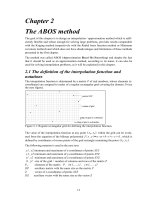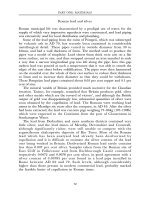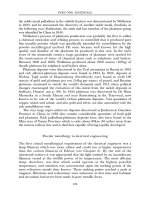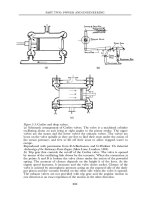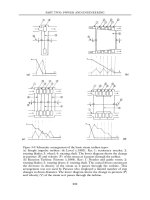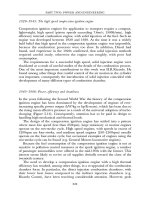Chapter 2 - The History of the IMS Standardization pps
Bạn đang xem bản rút gọn của tài liệu. Xem và tải ngay bản đầy đủ của tài liệu tại đây (333.67 KB, 15 trang )
Chapter 2
The History of the IMS
Standardization
In Chapter 1 we mentioned that the IMS (IP Multimedia Subsystem) uses Internet protocols.
When the IMS needs a protocol to perf orm a particular task (e.g., to establish a multimedia
session), the standardization bodies standardizing the IMS take the Internet protocol intended
for that task and specify its use in the IMS. Still, no matter how simple this may sound, the
process of choosing protocols to be used in the IMS can sometimes get tricky. Sometimes,
the Internet protocol that is chosen lacks some essential functionality, or does not even exist
at all. When this happens the IMS standardization bodies contact the standardization body
developing Internet protocols to work together on a solution. We will cover this collaboration
in Section 2.5. Nevertheless, before jumping into that we will introduce in Section 2.1 all
the standardization bodies involved in IMS development. We need to know who is who and
which functions of the IMS each of them performs.
2.1 Relations between IMS-related Standardization Bodies
The ITU (International Telecommunication Union) IMT-2000 (International Mobile Tele-
communications-2000) is the global standard for 3G networks. IMT-2000 is the result
of the collaboration between different standards bodies. It aims to provide access to
telecommunication services using radio links, which include satellite and terrestrial network s.
We will focus on two of the standard bodies involved in IMT-2000: 3GPP (Third
Generation Partnership Project) and 3GPP2 (Third Generation Partnership Project 2).
However, they are not the only ones working within IMT-2000. Other bodies, such as the
ITU-R (ITU-Radiocommunication Sector), for instance, are also involved in IMT-2000 but
in different areas from the IMS.
Both 3GPP and 3GPP2 have standardized their own IMS. The 3GPP IMS and the 3GPP2
IMS are fairly similar, but, nevertheless, have a few differences, mostly related to the
difference in the cellular aspects of 3GPP and 3GPP2 cellular networks.
An important similarity between the 3 GPP IMS and the 3GPP2 IMS is that both
use Internet protocols, which have been traditionally standardized by the IETF (Internet
Engineering Task Force). Consequently, both 3GPP and 3GPP2 collaborate with the IETF
in developing protocols that fulfill their requirements. The following sections introduce the
IETF, 3GPP, and 3GPP2 and provide a brief history of the IETF-3GPP/3GPP2 collaboration.
´ıa- M ar t´ın
The 3G IP Multimedia Subsystem (IMS): Merging the Internet and the Cellular Worlds Third Edition
Gonzalo Camarillo and Miguel A. Garc
© 2008 John Wiley & Sons, Ltd. ISBN: 978- 0- 470- 51662- 1
10
CHAPTER 2. THE HISTORY OF THE IMS STANDARDIZATION
In addition to the standard bodies we have just mentioned, OMA (Open Mobile Alliance
[226]) plays an important role in developing IMS services. While 3GPP and 3GPP2
have standardized (or are standardizing) a few IMS services, such as basic video calls or
conferencing, OMA focuses on the standardization of service enablers on top of the IMS
(of course, other standard bodies and third parties besides OMA may also develop services
and service enablers for the IMS).
Lately, additional standardization bodies have come on the scene since IMS made its
debut in the fixed broadband access arena. We are referring to Next Generation Networks
(NGN) for which IMS f o r ms a substantial part.
In 2004 the ITU-T created an NGN Focus Group (NGN-FG) that for a couple of years
studied and advanced the specification work of Next Generation Networks for fixed line
accesses based on IMS. In Europe, in 2004, the European Telecommunications Standards
Institute (ETSI) created the Telecoms and Internet converged Services and Protocols for
Advanced Networks (TISPAN) tech nical committee, with the goal of standa rdizing a Next
Generation Network for fixed network access based on IMS. ETSI TISPAN is contributing
to 3GPP to maintain a single set of IMS specifications. At the end of 2007, the common IMS
parts of ETSI TISPAN were transferred to 3GPP and the standardization of these common
IMS parts only take place in 3GPP.
In North America, the Alliance for Telecommunications Industry Solutions (ATIS), also
in 2004, created the NGN Focus Group to study the applicability of NGN and IMS to North
American fixed access networks. The three standardization bodies keep synchronized the
definition of NGN and the applicability of IMS to fixed access networks. In addition, they
also bring new requirements to 3GPP and 3GPP2 to support fixed broadband access to IMS.
But this is not all. In North America, the relevant initiative for the cable industry is the
PacketCable
TM
initiative led by CableLabs. The PacketCable 2.0 set of specifications defines
an application of IMS to cable networks for providing multimedia services. PacketCable has
been contributing to 3GPP to maintain a single set of IMS specifications.
2.2 Internet Engineering Task Force
The Internet Engineering Task Force (IETF) is a loosely self-organized collection of network
designers, operators, vendors, and research institutions that work together to develop the
architecture, protocols, and operation of the public Internet. The IETF is a body that is open
to any interested individual. It is not a corporation and, therefore, does not have a board of
directors, members, or dues.
The IETF is the standardization body that has developed most of the protocols that are
currently used on the Internet. The IETF does not standardize networks, architectures com-
bining different protocols, the internal behavior of nodes, or APIs (Application Programming
Interfaces). The IETF is the protocol factory for IP-related protocols.
2.2.1 Structure of the IETF
Work in the IETF is organized in working groups. Each working group is chartered to
perform specific tasks, such as the delivery of a precise set of documents. Each working
group has from one to three chairs, who ensure that the working group completes its chartered
tasks in time. Working groups have a temporary lifetime, so, once they have delivered their
documents, either they are rechartered or they cease to exist. Figure 2.1 shows a few, but not
2.2. INTERNET ENGINEERING TASK FORCE
11
all, of the working groups in the IETF; there are more than 100 active working groups in the
IETF. The complete up-to-date list of active working groups is available at:
/>Working groups get an acronym name that identifies the chartered task. For instance,
SIPPING is the acronym for Session Initiation Pro tocol I nvestigation, SIMPLE is the
acronym for SIP for Instant Messaging and Presence Leveraging Extensions, and AAA is
the acronym for Authentication, Authorization and Accounting.
A collection of working groups form an Area Directorate. Traditionally most of the
working groups of interest for the IMS have been part of the Transport Area, but some
groups were included in the Application Area or some other area. In March 2006 the IETF
created a new Real-Time Applications and Infrastructure (RAI) Area, whose main purpose is
to agglutinate all the working groups working around real-time communications, for example,
all the SIP-related working groups.
There are curr e ntly eight areas in the IETF, as illustr a ted in Figure 2.1. Note that not all
the IETF working groups are shown in Figure 2.1
Figure 2.1: The structure of the IETF
Each area has one or two area directors who, together with the IETF chairman, form the
IESG (Internet Engineering Steering Group). The IESG is the technical management team of
the IETF. They decide on which areas the IETF should work and review all the specifications
that are produced.
The following web pages contain the complete list of the working g roups of all areas and
the charter of the SIPPING working group, respectively:
/> />The IAB (Internet Architecture Board) is the body that provides technical leadership and
handles appeals. Its web page is at:
/>12
CHAPTER 2. THE HISTORY OF THE IMS STANDARDIZATION
2.2.2 Working Group Operations
The technical work in the IETF is done within the working groups. Working groups do
not have any kind of membership; they are formed by a number of volunteers who work as
individuals. That is, they do not represent their companies when working for the IETF.
Most of the technical discussions within a working group take place in its mailing list.
Even the decisions made at face-to-face meetings (held three times a year) h ave to be
confirmed in the mailing list.
The technical documents used within the working groups are called Internet-Drafts. There
are two types: individual submissions and working group items. Individual submissions are
technical proposals submitted by an individual or individuals. If the working group decides
that an individual submission is a good starting point to work on a particular topic, it becomes
a working group item.
Individual submissions and working group items can be distinguished by the name of the
file where they are stored. Individual submissions start with:
draft-author’s_name
while working group items start with:
draft-ietf-name_of_the_working_group
A list of all the Internet-Drafts can be found at:
/>When a working group feels that a working group item is ready for publication as an
RFC (Request for Comments) the working group chairs send it to the IESG. The IESG may
provide feedback to the working group (e.g., ask the working group to change something in
the draft) and, eventually, d ecides whether or not a new RFC is to be published.
Although most of the Internet-Drafts that the IESG receives come from working groups,
an individual may also submit an Internet-Draft to the IESG. This usually happens with topics
that are not large enough to grant the creation of a working group, but which, nevertheless,
are of interest to the Internet community.
It is important to note that Internet-Drafts, even if they are working group items, represent
work in progress and should only be referenced as such. Internet-Drafts are temporary
documents that expire and cease to exist six months after they h ave been issued. They can
change at any time without backward compatibility issues with existing implementations
being taken into consideration. Only when a particular Internet-Draft becomes an RFC can it
be considered a stable specification.
2.2.3 Types of RFCs
The technical documents produced by the IETF are called RFCs. According to the contents
of the document there are three main types of RFCs:
• standards-track RFCs;
• non-standards-track RFCs;
• BCP (Best Current Practice) RFCs.
2.2. INTERNET ENGINEERING TASK FORCE
13
Standards-track RFCs typically define protocols and extensions to protocols. According
to the maturity of the protocol there are three levels of standards-track RFCs: proposed
standard, draft standard, and Internet standard. Standards-track specifications are supposed
to advance from p roposed to draft and, finally, to Internet standard as they get more and
more mature. An important requirement in this process is that a particular specification is
implemented by several people to show that different independently built implementations
that follow the same specification can successfully inter-operate.
Nevertheless, in practice, only a few RFCs reach the draft standard level and even fewer
become Internet standards. At present, the specifications of many protocols that are used
extremely frequently on the Internet are proposed standards.
There are three types of non-standards-track RFCs: experimental, informational, and
historical (these are called historic RFCs). Experimental RFCs specify protocols with a very
limited use, while informational RFCs provide information for the Internet community about
some topic, such as a requirements document or a process. When a standards-track RFC
becomes obsolete, it becomes a historic RFC.
When a document is published as an RFC, a sequential RFC number is permanently
assigned to it, independently of the category of the RFC. In addition to the RFC number, a
document may also get an additional number in the BCP series or STD series, depending
on the category. For example, the Internet Protocol (IP) specified in RFC 791 [256] is also
STD 5.
BCP RFCs record the best current practice known to the community for performing a
particular task. They may deal with protocol issues or with administrative issues.
Figure 2.2 shows the relations between all the RFC types. A list of all the RFCs published
so far and their status can be fetched from:
/>Proposed
Standard
Draft
Standard
Standard
Experimental
Historic
Informational
Standards track Non-standards track
BCP
RFCs
Figure 2.2: RFC types
RFCs can be downloaded from the following web page by just entering the RFC number:
/>In addition, the RFC Editor offers a web page that allows us to search for RFCs by title,
number, author and keywords:
/>14
CHAPTER 2. THE HISTORY OF THE IMS STANDARDIZATION
2.3 Third Generation Partnership Project
The Third Generation Partnership Project (3GPP) was born in 1998 as a collaboration
agreement between a number of regional telecommunications standards bodies, known as
organizational partners. The current 3GPP organizational partners are:
1. ARIB (Association of Radio Industries and Business) in Japan,
/>2. CCSA (China Communications Standards Association) in China,
/>3. ETSI (European Telecommunications Standards Institute) in Europe,
/>4. ATIS (Alliance for Telecommunications Industry Solutions) in the United States of
America,
/>5. TTA (Telecommunications Technology Association) of Korea,
/>6. TTC (Telecommunication Technology Committee) in Japan,
/>3GPP was originally chartered to develop globally applicable technical specifications
and technical reports for a third generation mobile system based on GSM (Global System
for Mobile communication). The scope has been reinforced to include maintenance and
development of GSM specifications, including the supported and evolved radio networks,
technologies, and packet access technologies.
Besides the organizational partners, market representation partners provide the partner-
ship with market requirements. Market representation partners include, among others, the
IMS Forum, the UMTS Forum, 3G Americas, the GSM Association, the Global mobile
Suppliers Association, the TD-SCDMA Forum, and the IPv6 Forum.
3GPP maintains an up-to-date web site at:
/>2.4. THIRD GENERATION PARTNERSHIP PROJECT 2
15
2.3.1 3GPP Structure
3GPP is organized as a Project Co-ordination Group (PCG) and Technical Specification
Groups (TSGs), as illustrated in Figure 2.3. The PCG is responsible for the overall
management of 3GPP, time plans, allocation of work, etc. The technical work is produced
in the TSGs. At the moment there are four TSGs, responsible for the Core Network
and Terminals (CT), System and Services Aspects (SA), GSM EDGE Radio Access
Network (GERAN), and Radio Access Network (RAN). Each of the TSGs is further divided
into Working Groups. Each of the Working Groups is allocated particular tasks. For instance,
CT WG1 is responsible for all the detailed design of the usage of SIP and SDP in the IMS,
CT WG3 for interworking aspects, and CT WG4 for all the detailed design of the usage
of Diameter. SA WG1 is responsible for the requirements, SA WG2 for the architecture,
SA WG3 for the security aspects, SA WG4 for the codecs, and SA WG5 for the operation
and maintenance of the network, including charging aspects.
2.3.2 3GPP Deliverables
3GPP working groups do not produce standards. Instead, they produce Technical Specifica-
tions (TS) and Technical Reports (TR) that are approved by the TSGs. Once approved, these
are submitted to the organization al partners to be submitted to th eir respective standardization
processes. The final part of the process is in the organizational partners’ hands when they
approve the TSs or TRs as p art of their standards procedures. As a result, there is a set of
globally developed standards that are ready to be used in a particular region.
3GPP TSs and TRs are numbered according to a sequence of four or five digits that follow
the pattern “xx.yyy”. The first two digits “xx” identify the series number, and the last two
or three digits “yy” or “yyy” identify a particular specification within a series. For instance,
3GPP TS 23.228 [43] describes the architectural aspects of the IMS.
3GPP groups its specifications in what is called a Release. 3GPP Release 5 contains the
first version of the IMS. 3GPP Releases 6, 7, and so on contain enhancements and additional
functionality to the IMS. The reader must note that the IMS is just a fraction of the 3GPP
deliverables in a particular Release, as there are other non-IMS specifications included in a
3GPP Release. 3GPP TSs and TRs include a version number that follows the pattern “x.y.z”,
where “x” represents the 3GPP Release where the specification is published, “y” is the version
number, and “z” is a sub-version number. So, 3GPP TS 23.228 version 5.8.0 means version
8.0 of the Release 5 version of TS 23.228.
3GPP TSs and TRs are publicly available at the 3GPP web site at either of the following
URIs:
/> />2.4 Third Generation Partnership Project 2
If 3GPP was created to evolve GSM specifications into a third-generation cellular system,
the Third Generation Partnership Project 2 (3GPP2) was born to evolve North American
and Asian cellular networks based on ANSI/TIA/EIA-41 standards and CDMA2000
R
radio
access into a third-generation system. 3GPP2, like 3GPP, is a partnership project whose
members are also known as organizational partners. The current list o f organizational
16
CHAPTER 2. THE HISTORY OF THE IMS STANDARDIZATION
TSG SA
Services and
System Aspects
TSG GERAN
GSM EDGE Radio
Access Network
TSG RAN
Radio Access
Network
TSG CT
Core Network and
Terminals
PCG
Project Co-ordination
Group
RAN WG5
Mobile Terminal
Conformance
Texting
CT WG5
OSA Open
Service Access
CT WG6
Smart Card
Application
Aspects
SA WG1
Services
SA WG2
Architecture
SA WG3
Security
SA WG4
Codec
SA WG5
Telecom
Management
GERAN WG1
Radio Aspects
GERAN WG2
Protocol Aspects
GERAN WG3
Terminal Testing
RAN WG1
Radio Layer 1
spec.
RAN WG2
Radio Layer 2
spec & Radio
Layer 3 RR spec.
RAN WG3
Iub, Iur, Iu spec
& UTRAN O&M
requirements
RAN WG4 Radio
Performance
and Protocol
Aspects
CT WG1
Core Network &
Terminals
CT WG3
Interworking with
External
Networks
CT WG4
MAP/GTP/BCH/
SS
Figure 2.3: The structure of 3GPP
partners include ARIB (Japan), CCSA (China), TIA (Telecommunications Industry
Association) (North America), TTA (Korea), and TTC (Japan). Probably the reader has
noticed that most of them are also organizational partners of 3GPP.
Like 3GPP, 3GPP2 gets market requirements and advice from market representation
partners. At the moment the list includes the IPv6 Forum, the CDMA Development Group,
and the International 450 Association.
2.4.1 3GPP2 Structure
The 3GPP2 structure mimics the structure of 3GPP, as illustrated in Figure 2.4. The Steering
Committee (SC) is responsible for the overall standardization process and the planning.
The technical work is done in Technical Specification Groups (TSGs). TSG-A is focused
2.4. THIRD GENERATION PARTNERSHIP PROJECT 2
17
on the Access Networks Interfaces, TSG-C on CDMA2000 technology, TSG-S on Services
and System Aspects, and TSG-X on Intersystems Operations. TSG-X was born as a merger
between the former TSG-N (Core Networks) and TSG-P (Packet Data) TSGs, and devotes
itself to Core Networks.
TSG-A
Access Networks
Interfaces
TSG-C
CDMA 2000®
TSG-S
Services and
System Aspects
TSG-X
Core Networks
SC
Steering Committee
WG1
Program
Management
WG2
RAN Evolution
WG3
1x IOS
WG4
HRPD IOS
WG1
Application
Services
WG2 Signaling
and Protocols
WG3
Physical Layer
WG4
Performance
WG1
Requirements
WG2
Network
Reference
Architecture &
Network
Management
WG3
Program
Management
Team (PMT)
WG1
Evolution,
Requirements,
and Architecture
(ERA)
WG2
Circuit Swtiched
Network (CSN)
WG3
Billing,
Accounting, and
Numbering
(BAN)
WG4
Multimedia
Domain (MMD)
WG4
Security
WG5
OAM&P
WG5
Packet Data
Service (PDS)
Figure 2.4: The structure of 3GPP2
2.4.2 3GPP2 Deliverables
Like 3GPP, 3GPP2 does not produce standards but, instead, Technical Specifications and
Technical Reports. The documents are created by the TSGs and approved by the SC.
Then, they are submitted to the organizational partners to be submitted to their respective
standardization processes.
3GPP2 TSs and TRs are numbered with a sequence of letters and digits that follows the
scheme “A.Bcccc[-ddd]-X” version “y.z” where “A” is a letter that represents the name of the
18
CHAPTER 2. THE HISTORY OF THE IMS STANDARDIZATION
TSG that delivers the document, “B” can be a ’P’, ’R’, or ’S’ letter to indicate a project, report
or specification, respectively. “cccc” is a sequential number allocated to the document. An
optional “ddd” sequence of digits is used for multi-part documents. The “X” letter identifies
the revision, where “0” is the initial release, “A” is the first revision, and so on. The version
number follows the specification and indicates a major and minor version. For instance, the
specification X.S0013-002-A v1.0 represents the IP Multimedia Subsystem (IMS) Stage 2,
revision A, version 1.0.
3GPP2 TSs and TRs are publicly available at the 3GPP2 web site at:
/>Since 3GPP2 IMS specifications are based on corresponding 3GPP IMS ones, we focus
on the IMS defined by 3GPP. Sometimes, we will highlight differences between the networks,
when those differences are relevant to the discussion.
2.5 IETF-3GPP/3GPP2 Collaboration
As we mentioned in Chapter 1 the IMS aims to use Internet protocols. However, some of
the protocols chosen for use in the IMS arch itecture were not completely suitable for the
IMS environment. There were even cases where the IETF did not have any solution at all to
address some of the issues the IMS was facing.
One possibility would have been to take whatever IETF protoc ols were already there and
modify them to meet the requirements of the IMS. However, the goal of 3GPP and 3GPP2
was clear. They wanted the IMS to use Internet technologies. This way they could take
advantage of any future service created for the Internet. Modifying Internet p rotocols on
their own was not an option. Instead, they established a collaboration with the IETF to make
sure that the protocols developed there met their requirements.
The terms of this collaboration were documented in RFC 3113 [292] (3GPP-IETF) and
in RFC 3131 [91] (3GPP2-IETF). Both 3GPP and 3GPP2 nominated liaisons with the IETF
(Ileana Leuca, later Stephen Hayes, and later Hannu Hietalahti from 3GPP, and Tom Hiller
and later A. C. Mahendran from 3GPP2), and the IETF nominated a liaison with them
(Thomas Narten first and Gonzalo Camarillo later). In any case these collaborations took part
mostly at the working group level, without involving the official liaisons most of the time: for
example, groups of engineers discussing technical issues in mailing lists, IETF face-to-face
meetings, and special workshops. 3G engineers collaborated in providing wireless expertise
and requirements from the operators while IETF engineers p rovided protocol knowledge.
The goal was to find solutions that addressed the requirements of the IMS and that, at the
same time, were general enough to be used in other environments.
So far, several protocol specifications and protocol extensions have been published in the
form of RFCs and Internet-Drafts as the fruit of this collaboration. Most of them do not
need to mention the IMS, since they specify protocols with general applicability that are not
IMS-specific at all.
The following sections provide a brief history of the areas where the IETF collaborated
in developing protocols that are used in the IMS.
2.5.1 Internet Area
The area director driving the collaboration in the IETF Internet area was Thomas Narten.
The main areas of collaboration were IPv6 and DNS (Domain Name System).
2.5. IETF-3GPP/3GPP2 COLLABORATION
19
The IPv6 working group produced a specification (RFC 3316 [77]) that provides
guidelines on how to implement IPv6 in cellular hosts. When such a host detects that it
is using a GPRS access, it follows the guidelines provided in that specification. On the other
hand, if the same host is using a different access (e.g., WLAN), it behaves as a regular Internet
host. So, terminals behave differently depe nding on the type of access they are using, not on
the type of terminals they are.
In the DNS area there were discussions on how to perform DNS server discovery in the
IMS. It was d ecided not to use DHCP (Dynamic Host Configuration Protocol), but to use
GPRS-specific mechanisms instead. At that point there was no working group agreement on
stateless DNS server discovery procedures that could be used in the IMS.
2.5.2 Operations and Management Area
The main protocols in the IETF operations and management area where there was collabora-
tion between 3GPP and the IETF were COPS (Common Open Policy Service) and Diameter.
Both area directors, Bert Wijnen and Randy Bush, were involved in the discussions; Bert
Wijnen in COPS-related discussions and Randy Bush in Diameter-related discussions. Bert
Wijnen even participated in 3GPP CN3 meetings as part of this collaboration.
In the COPS area the IMS had decided to use COPS-PR in the Go interface, and so 3GPP
needed to standardize the Go Policy Information Base (PIB). However, in the IETF it was not
clear whether using COPS-PR for 3GPP’s purposes was a good idea. After a lot of discussions
the Go PIB was finally created (the IETF produced RFC 3317 [116] and RFC 3318 [293]).
In the Diameter area the IMS needed to define three Diameter applications to support
the Cx, Sh,andRo interfaces. Nevertheless, although new Diameter codes could only be
defined in RFCs, there was not enough time to produce an RFC describing these Diameter
applications and the new command codes that were needed. At last, the IETF agreed to
provide 3GPP with a number of command codes (allocated in RFC 3589 [210]) to be used
in 3GPP Release 5 with one condition: 3GPP need ed to collaborate with the IETF on
improving those Diameter applications until they became general enough. These resulted
in 3GPP contributing to the IETF with the Diameter SIP Application [150] and Diameter
Credit-Control Application [158]. The IMS is supposed to migrate to these new Diameter
applications in future releases.
2.5.3 Transport Area
Collaboration in the transport area was mainly driven by 3GPP (not much from 3GPP2). Two
people were essential to the collaboration in this area: Stephen Hayes, initial 3GPP liaison
with th e IETF an d chairman of CN, and Allison Mankin, transport area director in the IETF.
They ensured that all the issues related to signaling got the appropriate attention in both
organizations.
Everything began when 3GPP decided that SIP was going to be the session control
protocol in the IMS. At that point SIP was still an immature protocol that did not meet most
of the requirements 3GPP had. At that time SIP was defined in RFC 2543 [161], but there
was an Internet-Draft, commonly known as 2543bis, that had fixed some o f the issues present
in RFC 2543 and was supposed to become the next revision of the protocol specification.
However, 2543bis only had two active editors (namely Henning Schulzrinne and Jonathan
Rosenberg) and the 3GPP deadlines were extremely tough. A larger team was needed if the
SIP working group, where SIP was being developed, wanted to meet those deadlines. That is
20
CHAPTER 2. THE HISTORY OF THE IMS STANDARDIZATION
how Gonzalo Camarillo, Alan Johnston, Jon Peterson, and Robert Sparks were recruited to
edit the SIP specification that resulted in the current RFC 3261 [286].
After very many emails, conference calls, and face-to-face meetings the main outcome
of the team was RFC 3261 [286]. However, it was soon clear that 3GPP’s requirements
were not going to be met with a single protocol. The input 3GPP requirements to SIP
were documented in RFC 4083 [202]. A few extensions were needed to fulfill them all.
In fact, there were so many requirements and so many extensions needed that the SIP working
group was overloaded (other working groups, like MMUSIC, SIMPLE, or ROHC, were also
involved, but the main body of the work was tackled by SIP). A new process was needed to
handle all of this new work.
The IETF decided to create a new working group to assist SIP in deciding how to best
use its resources. The new working group was called SIPPING, and its main function was
to gather requirements for SIP, prioritize them and send them to the SIP working group,
which was in charge of doing the actual protocol work. This new process was documented in
RFC 3427 [214].
At present, most of the protocol extensions related to session establishment needed
by 3GPP are finished or quite advanced. As a consequence the 3GPP focus moved
towards the SIMPLE working group, which develops SIP extensions for presence and instant
messaging. 3GPP members actively p articipated in the development of the presence and
instant messaging specifications, which were adopted by 3GPP, 3GPP2, the Open Mobile
Alliance, and other SDOs.
2.6 Open Mobile Alliance
In June 2002, the Open Mobile Alliance (OMA) was created to provide interoperable mobile
data services. A number of existing forums at that time, such as the WAP Forum and Wireless
Village, were integrated into OMA. Nowadays, OMA includes companies representing most
segments of industry. Vendors, service providers, and content providers are all represented in
OMA. The OMA web site can be found here:
/>OMA pays special attention to usability and to creating service enablers that allow
interoperability of services. Th at is, OMA service enablers need to be easy to use. In OMA,
spending time thinking about how users will interact with a particular service is routine.
Figure 2.5 shows the structure of OMA. The Technical Plenary is responsible for the
approval and maintenance of the OMA specifications. It consists of a number of Technical
Working Groups and, at the time of writing, two Committees.
The Operations and Processes Committee defines and supports the operational processes
of the Techn ical Plenary. The Release Planning and Management Committee plans and
manages the OMA releases, which are b ased on the specifications developed by the Technical
Working Groups.
2.6.1 OMA Releases and Specifications
OMA produces Release Packages. Each of these packages consists of a set of OMA
specifications, which are the documents produced by the OMA Technical Working Groups.
For example, the Enabler Release Package for PoC Version 1.0 [232] includes an
Enabler Release Definition document [229] that provides a high-level definition of the
2.6. OPEN MOBILE ALLIANCE
21
Technical Plenary
Requirements
Architecture
Security
Interoperability
Browser
Technologies
Broadcasting
Content
Distribution
Device
Management
Data
Synchronization
Developers'
Interests
Location
Messaging
Mobile Commerce
and Charging
Presence and
Availability
Push-to-Talk Over
Celullar
Board of Directors
Release Planning and
Management Committee
Operations and
Processes Committee
Digital Rights
Management
Game Services
Figure 2.5: OMA structure
PoC (Push-to-talk over Cellular) service and lists the specifications contained in the
Enabler Release Package. In addition, the Enabler Release Package includes the following
specifications:
• architecture [233]
• requirements [235]
• control plane specification [234]
• user plane specification [236]
• XDM (XML Document Management) specification [237] (which defines data formats
and XCAP (XML Configuration Access Protocol) application usages for PoC).
OMA defines maturity levels for its releases. The maturity levels are called phases in
OMA terminology. Each OMA Release Package can be in one of the following phases:
• Phase 1: Candidate Enabler Release. This is the initial state of the release.
• Phase 2: Approved Enabler Release. The release has successfully passed interoper-
ability tests.
22
CHAPTER 2. THE HISTORY OF THE IMS STANDARDIZATION
• Phase 3: OMA Interoperability Release. The release has successfully passed
exhaustive interoperability tests that may involve interoperability with other OMA
service enablers.
As the definitions of the various release phases clearly state, interoperability tests play
a key role in OMA. The OMA interoperability tests are referred to as Test Fests and
are organized by the Interoperability (IOP) Technical Working Group, which specifies the
processes and programs for the Test Fests.
2.6.2 Relationship between OMA and 3GPP/3GPP2
A number of OMA Technical Working Groups use the IMS to some degree. As a
consequence, we need to look at the relationship between OMA and some of its Technical
Working Groups with 3GPP and 3GPP2 with respect to the IMS.
Some of the OMA work uses the IMS as a base. Therefore there are situations where an
OMA Technical Working Group comes up with new requirements on the IMS that need to be
met in order to implement a new service.
In general, the agreement between 3GPP, 3GPP2 and OMA is that OMA generates
requirements on the IMS, and 3GPP and 3GPP2 extend the IMS to meet these new
requirements. This agreement tries to avoid having different versions of the IMS: the
3GPP IMS and the IMS as extended by OMA. Having a single organization managing
and maintaining the specifications o f the IMS ensures interope rability between th e IMS
implementations of different vendors.
Still, there is no clear-cut distinction between the IMS and the services on top of it.
A multimedia session between two participants may be considered a service by some, but
it is part of the IMS, as discussed in Chapter 5. Conferencing can also be considered to be a
service, but it is specified by 3GPP as part of the IMS. Presence is an interesting area as well,
because both 3GPP and OMA have ongoing work related to presence.
However, even when both 3GPP and OMA work on similar issues, such as presence, they
aim to have compatible specifications. For example, the OMA specifications developed b y
the Presence and Availability Technical Working Group focus on different aspects of presence
from the 3GPP presence-related specifications. Nevertheless, all these specifications are
compatible.
Another example of an area where both OMA and 3GPP perform activities is messaging.
While 3GPP focuses on specifying instant messaging services for the IMS using the work of
the IETF SIMPLE WG as a base (e.g., the SIP MESSAGE method and MSRP), OMA focuses
on the interworking between SIMPLE-based and Wireless Village-based instant messaging
and on the evolution of MMS (Multimedia Messaging Service).
In order to ensure that every OMA service uses the IMS (as specified by 3 GPP and
3GPP2) in a consistent and interoperable way, OMA has produced the IMSinOMA Enabler
Release Package [230]. This release package includes an Enabler Release Definition
document [228], a Requirements document [239] and an Architecture document [238]. This
release package also describes how non-IMS-based OMA services can interoperate with
IMS-based OMA services.
2.6.3 Relationship between OMA and the IETF
In the same way as the 3GPP and 3GPP2 IMS specifications refer to IETF protocols
and extensions, OMA specifications also include references to IETF documents. The
2.6. OPEN MOBILE ALLIANCE
23
standardization collaboration between OMA and the IETF (documented in RFC 3975 [169])
consists mainly of working-group-level communications. A set of engineers collaborate
with both OMA and the IETF. They bring OMA requirements to the relevant IETF working
groups, which analyze them and develop appropriate solutions.
However, sometimes communications at the working group level are insufficient.
To handle these cases, both OMA and the IETF have appointed a liaison to each other. At the
time of writing, the OMA liaison to the IETF is Ileana Leuca and the IETF liaiso n to OMA
is Dean Willis.
OMA maintains a web page at the following address that allows both organizations to
track the status of the IETF Internet-Drafts that the OMA Technical Working Groups need:
/>
